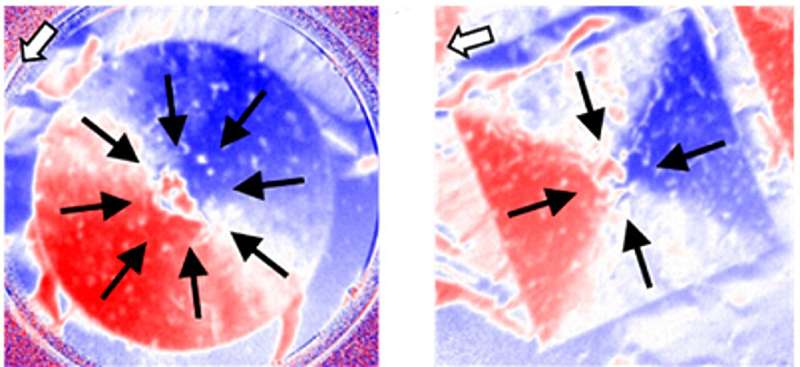Radially aligned spin textures in circular and square samples composed of ferromagnetic material on superconducting YBCO islands. The white arrow shows the incident X-ray beam. Image source: HZB
In some materials, spins form complex magnetic structures at the nanometer and micrometer scales, where the magnetization twists and curls along specific directions. Examples of such structures are magnetic bubbles, skyrmions, and magnetic vortices.
The goal of spintronics is to use such tiny magnetic structures to store data or perform logic operations with very low power consumption compared to today’s dominant microelectronic components. However, the generation and stability of most magnetic textures is limited to a few materials and can be achieved under very specific conditions (temperature, magnetic field, etc.).
An international collaboration led by HZB physicist Dr. Sergio Valencia has now investigated a new method for creating and stabilizing complex spin textures, such as radial vortices, in a variety of compounds. In radial eddy currents, the magnetization is directed toward or away from the center of the structure. This type of magnetic configuration is usually very unstable.
In this novel approach, radial vortices are generated with the help of superconducting structures, whose stability is achieved by the presence of surface defects.
Superconducting YBCO Island
The sample consists of micron-sized islands made of the high-temperature superconductor YBCO with ferromagnetic compounds deposited on them. After cooling the sample below 92 Kelvin (-181 °C), YBCO enters a superconducting state.
In this state, an external magnetic field is applied and immediately removed. This process allows the penetration and pinning of magnetic flux quanta, which in turn generates stray magnetic fields.
It is this stray field that creates new magnetic microstructures in the ferromagnetic layer above: spins are emitted radially from the center of the structure, like radial vortices.
The role of defects
As the temperature increases, YBCO transitions from a superconducting state to a normal state. Therefore, the stray field generated by the YBCO island disappears and the magnetic radial eddy currents should also disappear. However, HZB researchers and collaborators observed that the presence of surface defects prevents this from happening: even at temperatures close to room temperature, the radial vortices partially retain the imprinted state.
“We use the magnetic field generated by the superconducting structure to imprint certain magnetic domains on a ferromagnet placed on top of it, and use surface defects to stabilize them. This magnetic structure is similar to skyrmions and is interesting for spintronic applications ,” Valencia explained. .
Geometry is important
The smaller imprinted vortices are about 2 microns in diameter, about 10 times the size of a typical skyrmion. The research team studied samples with circular and square geometries and found that circular geometry increased the stability of imprinted magnetic radial eddy currents.
“This is a novel method of creating and stabilizing such structures that can be applied to a variety of ferromagnetic materials. These bring excellent new prospects for the further development of superconducting spintronics,” Valencia said.
The research is published in the journal ACS Applied Materials & Interfaces.
More information:
David Sanchez-Manzano et al., Size dependence and high-temperature stability of radial vortex magnetic textures imprinted by superconducting stray fields, ACS Applied Materials & Interfaces (2024). DOI: 10.1021/acsami.3c17671
Courtesy of the German Research Center Helmholtz Association
citation: Spintronics: A new path to room-temperature spin spin textures (2024, April 17) Retrieved April 19, 2024, from https://phys.org/news/2024-04-spintronics-path – room-Temperature-swirling.html
This document is protected by copyright. No part may be reproduced without written permission except in the interests of fair dealing for private study or research purposes. Content is for reference only.
#Spintronics #approach #roomtemperature #spinning #spin #textures
Image Source : phys.org
